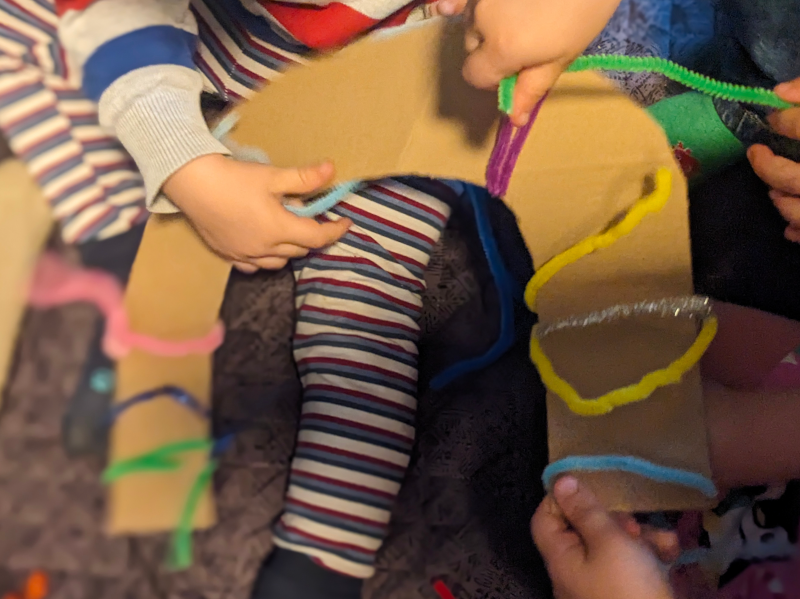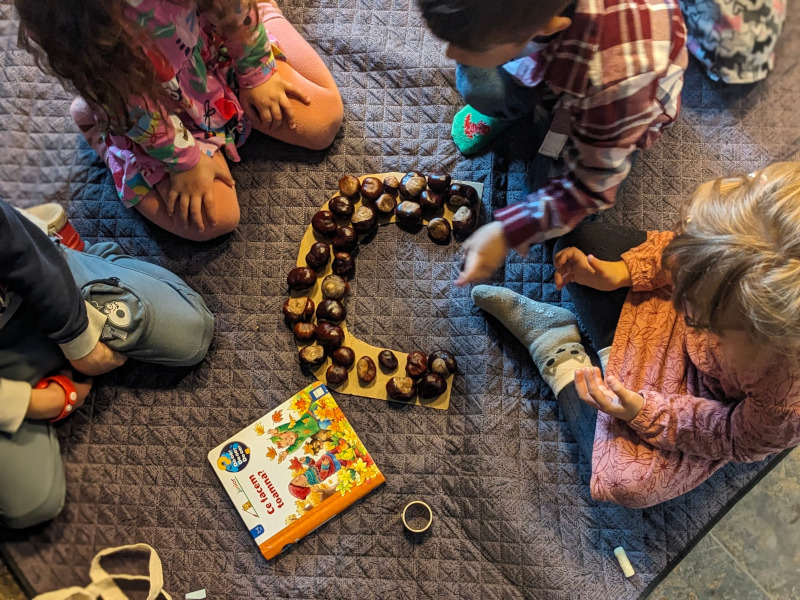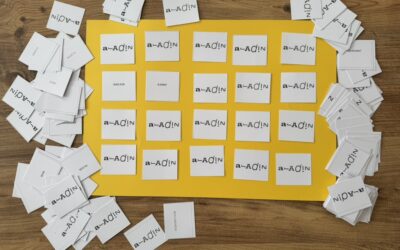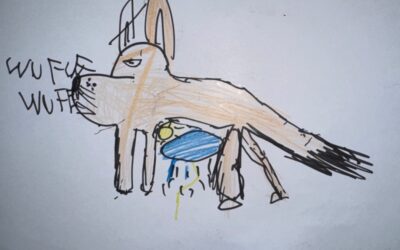Sensorial Writing
Sensorial Writing
This activity combines storytelling with hands-on sensory exploration to build vocabulary and creative expression. Children engage with a themed story, explore related objects, and use them to form letters or words.
Time
40 min
Children 2-6 years old
Up to 20 Participants
Language skills
A1 to C1
Learn & Gain
Children develop vocabulary, sensory awareness, oral expression, and fine motor skills. They practice descriptive language, creative thinking, and storytelling in a fun, multisensory environment that supports both individual and group learning.
Book, cardboard letters, stones, chestnuts, marbles, chenille sticks, outdoor materials.

Adaptable to:
All languages
1. Preparation
- Choose a Theme: Select a theme for the session (e.g., Autumn, Forest, Ocean).
- Select a Story: Pick a children’s book or create a short story that fits the chosen theme.
- Gather Materials: Collect a variety of sensory objects related to the theme (e.g., chestnuts, leaves, stones, pinecones, wood pieces).
– For younger children: Prepare cardboard letters or simple word cards.
– For older children: Provide paper, pencils, and markers.
2. Story Time
- Read the chosen story aloud to the group, emphasizing key vocabulary related to the theme.
- Encourage children to listen for words that describe sensory experiences (what they see, touch, smell, hear).
3. Sensory Exploration
- Invite children to explore and handle the sensory objects.
- Discuss the objects together: What do they feel like? What do they remind you of? What words can you use to describe them?
- Ask the children to remember words from the story that are connected to the objects.
4. Writing with Sensory Materials
- For Younger Children:
– Give each child a cardboard letter or word card.
– Ask them to cover the letter with sensory materials that start with that letter (e.g., “L” for leaf, “S” for stone).
– Say the letter and word aloud together.
- For Older Children:
– Challenge them to use the sensory materials to form whole words from the story or theme.
– Encourage them to write or draw words or short phrases that describe their sensory experience (e.g., “smooth stone,” “crunchy leaf”).
5. Sharing and Reflection
- Invite children to show their creations to the group.
- Ask them to describe what they made and why they chose certain materials.
- Encourage children to use new vocabulary and descriptive language.
6. Extension (Optional)
- Create a group collage or mural using the sensory materials and words.
- Encourage children to invent their own short story or poem using the words and objects explored.
7. Clean-Up and Closing
- Help children tidy up the materials.
- Recap the new words learned and praise their creativity and participation.

For Educators, Teachers and Parents
In the following section you’ll find additional information to help you adapt this activity for different audiences, language abilities and group sizes. This information should help educators and teachers to adapt the activity to meet the specific needs of different learners and to ensure accessibility, engagement and effectiveness in different learning environments. Optionally, we also give advices to parents how to condct the activity at home.
Adaptation/Application of the method
1. A Group with Varied Language Proficiency
- Use simple, clear instructions and model the activity step by step.
- Offer visual aids and real objects to support understanding and vocabulary retention.
- Allow children to express ideas using drawings or gestures if verbal skills are limited.
- Pair children with different proficiency levels to encourage peer support and language modeling.
2. For Bilingual/Multilingual Options
- Present key vocabulary in multiple languages; encourage children to share words in their home language and the activity language.
- Invite parents or peers to help translate or explain sensory experiences.
- Create bilingual word walls or labels for sensory objects, supporting both languages.
- Encourage children to describe the same object in more than one language, fostering cross-linguistic connections.
3. Cultural Contexts
- Select stories, sensory materials, and themes that reflect the cultural backgrounds of participants.
- Encourage children to bring sensory objects from home that are meaningful in their culture.
- Discuss and compare how different cultures describe sensory experiences (e.g., how autumn smells or feels in different countries).
- Use figurative language and metaphors from various cultures to enrich descriptive writing.
4. Other Age Groups
- For younger children: Focus on letter formation, simple word building, and tactile exploration with large, easy-to-handle materials.
- For older children: Challenge them to write full sentences or descriptive paragraphs about their sensory experiences, or to create storiesusing advanced vocabulary.
- Adjust the complexity of the writing task and the amount of adult support according to developmental stage.
5. Distant and online learning
- Send a list of easily found sensory materials to families ahead of time.
- Alternatively: allow 10 minutes for the participants to search for sensory materials in thier rooms after the lecture took place.
- Use virtual meetings to read stories and guide children through the activity, encouraging them to share their creations on camera.
- Provide printable templates or digital graphic organizers for children to record sensory words and experiences.
- Use association games of objects and sensory words that children can solve online.
- Encourage families to take photos of their sensory writing and share them with the group or teacher.
- Create a visual gallery (PollUnit) – learners can upload their final result and directly vote on their classmates’ creations.
Challenges
- Language Barriers: Use visuals, gestures, and home language support to help understanding.
- Limited Materials: Encourage the use of everyday household items as sensory materials.
- Varying Engagement Levels: Alternate between movement, sensory play, and writing to keep children interested.
- Mess or Overstimulation: Set clear boundaries for sensory play and offer calming breaks if needed.
- Distance Learning: Provide clear instructions and support for parents to facilitate the activity at home.
Recommendations for teachers
Preparation:
- Prepare enough materials for all children, or, if the times and setting allows, gather the materials together outdoors after the lecture. Thelecture could take place outdoors in this case.
- Safety First: Ensure all sensory materials are non-toxic and appropriate for the age group. Supervise closely to prevent choking hazards.
Expected output:
- Language Development: Children will use and reinforce new vocabulary related to the story and sensory materials.
- Creative Expression: Each child will create a unique letter, word, or phrase using sensory objects, reflecting their personal experience and imagination.
- Descriptive Skills: Children will practice describing textures, shapes, and sensations, both orally and in writing.
- Increased Engagement: The hands-on, multisensory approach will make language learning fun and memorable, encouraging active participation from allchildren.
Recommendations parents
- Prepare a safe, sensory-friendly space at home with a variety of materials for exploration.
- Gather the materials together on a walk outdoors.
- Read the story aloud and emphasize new or interesting words.
- Guide children in describing objects using all five senses, modeling descriptive language.
- Encourage creativity and allow children to express themselves through moving and showing the materials, drawing, speaking, or writing,depending on their age and comfort.
- Celebrate effort and creativity, not just correct spelling or grammar.
References and Resources
Other similar activities EN:
https://www.prekinders.com/sensory-writing-trays-tactile-letters/
https://thekindergartenconnection.com/touch-trace-sensory-writing-tray/
Images from the testing workshop: © Petronela Bordeianu (Koopkultur e. V.)
Similar Activities
True and False Friends – a Memory Game
With this game, learners not only improve their vocabulary, avoiding lexical pitfalls while also benefitting from existing knowledge of the majority language. They also playfully gain a better understanding of the historical and cultural ties that link their heritage language to the majority language.
Proverbidioms
This activity helps participants understand idioms by turning them into creative drawings. While having fun, they learn the meaning behind unusual expressions, explore how language works, and practice using their imagination.



